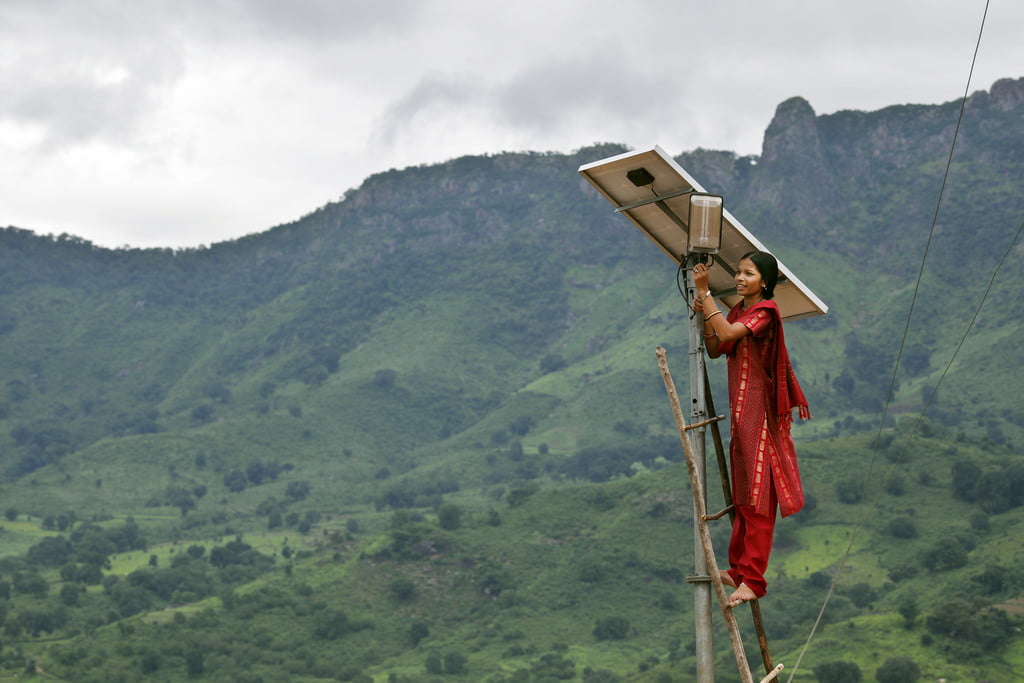Solar is booming in India, but the country’s solar panel industry could be facing a dimmer future.
At the end of this year, India will end its “domestic content requirement” for solar projects that are part of its National Solar Mission, a component of the country’s National Action Plan on Climate Change. A World Trade Organization ruling from last year is to blame. India will continue to expand on solar, but nearly all of those panels might soon be imported from other countries.
This is a problem because a key part of India’s enthusiasm for solar was tied to the a desire to develop a new high-tech industry. Instead, as India expands its solar capacity, it could end up reliant on China, which exports panels at bargain-basement prices, to meet its energy needs.
Both Indian Prime Minister Narendra Modi and his predecessor, Manmohan Singh, championed solar as a way to connect the hundreds of millions of Indians who remain without electricity to the country’s rapidly expanding grid. In 2015, Modi announced his intention to add 100 gigawatts of solar by 2022, a goal that was initially seen as lofty but that has been helped along by plummeting solar prices. India hasn’t hit its annual targets each year, but has expanded solar rapidly enough that the 100 gigawatt goal remains within reach. The country is now pondering a new target of 175 gigawatts. (For reference, a single gigawatt is enough energy to power hundreds of thousands of North American homes — and many more in the developing world.)
The Indian government’s embrace of solar has helped the country begin to decrease its reliance on coal. That, in turn, has helped international efforts to confront climate change maintain their momentum — even as the US has abandoned the Paris Agreement. The fact that relatively poor, populous and coal-reliant countries like India and China are increasingly turning to renewables despite the US’s refusal to cooperate are encouraging successes in the face of a major setback.
As originally conceived by Singh’s and Modi’s governments, India’s solar effort would involve mandates that a percentage of the solar panels come from manufacturers based in India — these mandates were the “domestic content requirements” (DCRs) that the WTO found to be overly protectionist. The plan, under the Solar Mission, was that India’s solar industry would grow to meet the demand created by the DCRs, and would eventually be able to make panels that could compete with the cheap and abundant ones manufactured in China, or the technologically advanced ones manufactured in the US. India’s growing solar industry would then create jobs for Indian workers, and a potential export for the country.
But in announcing its intention to build a robust solar industry, India became a target for China and the US, the world’s two dominant producers of solar panels who had for years been lobbing complaints back and forth at one another through the WTO, each trying to slap down the other’s policies aimed at protecting their domestic solar manufacturers from international competition.
In 2014, the US government, under pressure from it’s own domestic solar manufacturers and green tech investors, filed a complaint against India’s DCRs with the WTO. In 2016, the WTO ruled against India. At the time, India’s joint secretary of new and renewable energy told the trade publication PV Tech that the ruling would “not affect the future course of action” — India’s ambitious plans for ramping up solar generation would move ahead, with or without the DCRs.
But when, in December, the DCRs disappear, the country’s domestic solar manufacturers will have to operate for the first time without government protection assuring a certain amount of demand for Indian-produced panels, and some are worried that this could spell the end of the Indian solar industry. “A lot of local companies, local solar panel manufacturers are going to die out,” Ritesh Pothan, a clean energy consultant in Mumbai, told ClimateHome’s Sapna Gopal. The Indian Renewable Energy Ministry is still weighing other policies that could help protect the domestic solar industry but that would not be struck down by the WTO, but they haven’t yet arrived.
These Chinese panels are so cheap that they make solar a more affordable option than coal; Indians accuse China of selling solar panels at artificially low prices — prices that are even lower than the cost of producing the panels — in order to maintain its near monopoly on India’s solar market, a practice called dumping. Ultimately, the end of India’s solar protectionism could prove another small step forward for China as it seeks to become a dominant player in providing solutions to climate change — and claims the profits and influence that come along with that dominance.
China’s cornering of the solar market is both good and bad news as countries around the world work to meet their commitments under the Paris Agreement. The good news is that China’s solar panels are cheap and abundant, and able to compete with coal in many developing countries. More than any other country, China has been able to turn the fight to avert global catastrophe into an economic opportunity. The bad news: Increasingly, China is enjoying a virtual monopoly on solar in developing countries, with the ability to control the price of panels, the supply of panels, the type of panels manufactured and the rate at which the technologies in those panels improve. India, an enormous market, could become the latest example.
